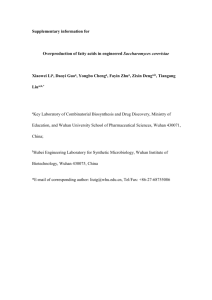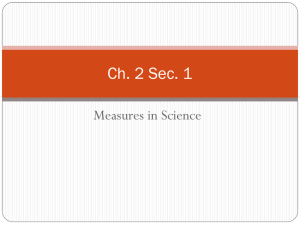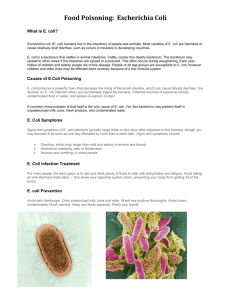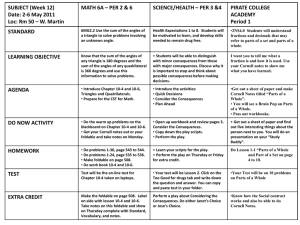bit25323-sm-0001-SuppData-S1
advertisement
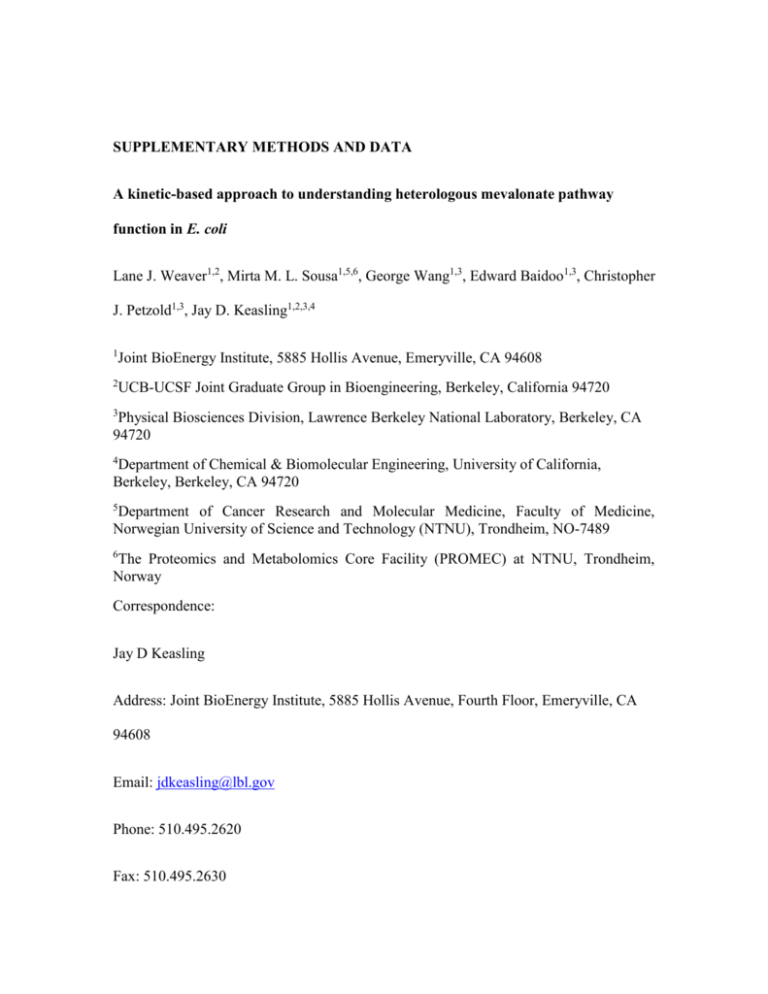
SUPPLEMENTARY METHODS AND DATA A kinetic-based approach to understanding heterologous mevalonate pathway function in E. coli Lane J. Weaver1,2, Mirta M. L. Sousa1,5,6, George Wang1,3, Edward Baidoo1,3, Christopher J. Petzold1,3, Jay D. Keasling1,2,3,4 1 Joint BioEnergy Institute, 5885 Hollis Avenue, Emeryville, CA 94608 2 UCB-UCSF Joint Graduate Group in Bioengineering, Berkeley, California 94720 3 Physical Biosciences Division, Lawrence Berkeley National Laboratory, Berkeley, CA 94720 4 Department of Chemical & Biomolecular Engineering, University of California, Berkeley, Berkeley, CA 94720 5 Department of Cancer Research and Molecular Medicine, Faculty of Medicine, Norwegian University of Science and Technology (NTNU), Trondheim, NO-7489 6 The Proteomics and Metabolomics Core Facility (PROMEC) at NTNU, Trondheim, Norway Correspondence: Jay D Keasling Address: Joint BioEnergy Institute, 5885 Hollis Avenue, Fourth Floor, Emeryville, CA 94608 Email: jdkeasling@lbl.gov Phone: 510.495.2620 Fax: 510.495.2630 Supplementary table I. Peptides used in synthetic Mev2.0 QconCat protein Gene Peptide sequence E. coli atoB LGDGQVYDVILR S. cerevisiae HMGS GLVSDPAGSDALNVLK S. aureus HMGS SGYEDAVDYNR S. cerevisiae HMGR SVVAEATIPGDVVR S. aureus HMGR LIGTIEVPMTLAIVGGGTK S. cerevisiae MK SLVFQLFENK M. mazei MK ASYDFLGK, QAVEDVHK S. aureus MK IGEQLVLSGDYASIGR S. cerevisiae PMK VQWLDVTQADWGVR S. cerevisiae PMD LYQLPQSTSEISR E. coli IDI YELGVEITPPESIYPDFR, LSAFTQLK E. coli NUDB WLDAPAAAALTK E. coli ISPA STYPALLGLEQAR A. grandis GPPS AAPLLGLADYVAFR M. spicata LS LADDLGTSVEEVSR A. grandis BIS LLIVDNIVR A. annua ADS VPGEIILEDALGFTR Supplementary table II. Enzyme constants used in modeling studies Enzyme kcat (s-1) Km (M) S. cerevisiae mevalonate kcat1 Km1 38 131×10-6 Ki (M) Reference 1.9×10-6 (Primak et al., kinase (scMK) S. aureus mevalonate 2011) kcat1 6 Km1 41×10-6 46×10-6 kinase (saMK) S. cerevisiae (Voynova et al., 2003) kcat2 10 Km2 885×10-6 Garcia et al. kcat3 4.9 Km3 123×10-6 (Krepkiy and phosphomevalonate kinase (scPMK) S. cerevisiae mevalonate diphosphate Miziorko, decarboxylase (scPMD) 2004) E. coli Isopentenyl- kcat4 0.33 Km4 8×10-6 (Hahn et al., diphosphate Isomerase 1999) (ecIDI) E. coli farnesyl kcat5 0.21 Km5-IPP 1.3×10-6 (Ku et al., Km5-DMAPP 29.3×10-6 Km6-IPP 10.3×10-6 Km6-GPP 5.5×10-6 2005) Km7 3.3×10-6 (Picaud et al., pyrophosphate synthase 2005) (ecISPA, reaction 1) E. coli farnesyl kcat6 0.47 pyrophosphate synthase 74×10-6 (Ku et al., (ecISPA, reaction 2) A. annua Amorphadiene Synthase (aaADS) kcat7 6.8×10-3 2005) Supplementary table III. Enzyme concentrations used in modeling studies Strain mbis3 (μM) saMK3 (μM) 10kADS (μM) Enzyme scMK 66.3 saMK 23.2 scPMK 2.9 4.9 14.1 scPMD 2.2 2.7 2.3 ecIDI 18.4 15.3 21.6 ecISPA 35.0 36.8 24.2 aaADS 39.6 25.6 678 Equations used in modeling studies (1) 𝑑[𝑀𝑒𝑣𝑃] 𝑑𝑡 = 𝑘𝑐𝑎𝑡 1 [𝑀𝐾][𝑀𝑒𝑣] [𝐹𝑃𝑃] 𝐾𝑚1 (1+ 𝐾𝐼,𝐹𝑃𝑃 )+[𝑀𝑒𝑣] − 𝑘𝑐𝑎𝑡 2 [𝑃𝑀𝐾][𝑀𝑒𝑣𝑃] 𝐾𝑚2 +[𝑀𝑒𝑣𝑃] (2) 𝑑[𝑀𝑒𝑣𝑃𝑃] 𝑑𝑡 (3) = 197 𝑘𝑐𝑎𝑡 2 [𝑃𝑀𝐾][𝑀𝑒𝑣𝑃] 𝐾𝑚2 +[𝑀𝑒𝑣𝑃] − 𝑘𝑐𝑎𝑡 3 [𝑃𝑀𝐷][𝑀𝑒𝑣𝑃𝑃] 𝐾𝑚3 +[𝑀𝑒𝑣𝑃𝑃] 𝑑[𝐼𝑃𝑃] 𝑑𝑡 = 𝑘𝑐𝑎𝑡 3 [𝑃𝑀𝐷][𝑀𝑒𝑣𝑃𝑃] 𝐾𝑚3 +[𝑀𝑒𝑣𝑃𝑃] − 𝑘𝑐𝑎𝑡 4 [𝐼𝐷𝐼][𝐼𝑃𝑃] 𝐾𝑚4 +[𝐼𝑃𝑃] + 𝑘𝑐𝑎𝑡 5 [𝐼𝑆𝑃𝐴][𝐼𝑃𝑃][𝐷𝑀𝐴𝑃𝑃] 𝐾𝑚5,𝐼𝑃𝑃 [𝐷𝑀𝐴𝑃𝑃]+𝐾𝑚5,𝐷𝑀𝐴𝑃𝑃 [𝐼𝑃𝑃]+[𝐷𝑀𝐴𝑃𝑃][𝐼𝑃𝑃] 𝑘𝑐𝑎𝑡 4 [𝐼𝐷𝐼][𝐷𝑀𝐴𝑃𝑃] 𝐾𝑚4 +[𝐷𝑀𝐴𝑃𝑃] − − 𝑘𝑐𝑎𝑡 6 [𝐼𝑆𝑃𝐴][𝐼𝑃𝑃][𝐺𝑃𝑃] 𝐾𝐼,𝐺𝑃𝑃 𝐾𝑚6,𝐼𝑃𝑃 +𝐾𝑚6,𝐼𝑃𝑃 [𝐺𝑃𝑃]+𝐾𝑚6,𝐺𝑃𝑃 [𝐼𝑃𝑃]+[𝐺𝑃𝑃][𝐼𝑃𝑃] (4) 𝑑[𝐷𝑀𝐴𝑃𝑃] 𝑑𝑡 = 𝑘𝑐𝑎𝑡 4 [𝐼𝐷𝐼][𝐼𝑃𝑃] 𝑘𝑐𝑎𝑡 4 [𝐼𝐷𝐼][𝐷𝑀𝐴𝑃𝑃] − 𝐾𝑚4 + [𝐼𝑃𝑃] 𝐾𝑚4 + [𝐷𝑀𝐴𝑃𝑃] 𝑘𝑐𝑎𝑡 5 [𝐼𝑆𝑃𝐴][𝐼𝑃𝑃][𝐷𝑀𝐴𝑃𝑃] 𝐾𝑚5,𝐼𝑃𝑃 [𝐷𝑀𝐴𝑃𝑃] + 𝐾𝑚5,𝐷𝑀𝐴𝑃𝑃 [𝐼𝑃𝑃] + [𝐷𝑀𝐴𝑃𝑃][𝐼𝑃𝑃] − (5) 𝑑[𝐺𝑃𝑃] 𝑑𝑡 = 𝑘𝑐𝑎𝑡 5 [𝐼𝑆𝑃𝐴][𝐼𝑃𝑃][𝐷𝑀𝐴𝑃𝑃] 𝐾𝑚5,𝐼𝑃𝑃 [𝐷𝑀𝐴𝑃𝑃]+𝐾𝑚5,𝐷𝑀𝐴𝑃𝑃 [𝐼𝑃𝑃]+[𝐷𝑀𝐴𝑃𝑃][𝐼𝑃𝑃] − 𝑘𝑐𝑎𝑡 6 [𝐼𝑆𝑃𝐴][𝐼𝑃𝑃][𝐺𝑃𝑃] 𝐾𝐼,𝐺𝑃𝑃 𝐾𝑚6,𝐼𝑃𝑃 +𝐾𝑚6,𝐼𝑃𝑃 [𝐺𝑃𝑃]+𝐾𝑚6,𝐺𝑃𝑃 [𝐼𝑃𝑃]+[𝐺𝑃𝑃][𝐼𝑃𝑃] (6) 𝑑[𝐹𝑃𝑃] 𝑑𝑡 𝑘𝑐𝑎𝑡 6 [𝐼𝑆𝑃𝐴][𝐼𝑃𝑃][𝐺𝑃𝑃] 𝑘𝑐𝑎𝑡 7 [𝐴𝐷𝑆][𝐹𝑃𝑃] − 𝐾𝐼,𝐺𝑃𝑃 𝐾𝑚6,𝐼𝑃𝑃 + 𝐾𝑚6,𝐼𝑃𝑃 [𝐺𝑃𝑃] + 𝐾𝑚6,𝐺𝑃𝑃 [𝐼𝑃𝑃] + [𝐺𝑃𝑃][𝐼𝑃𝑃] 𝐾𝑚7 + [𝐹𝑃𝑃] = (7) 𝑑[𝐴𝑀𝑂] 𝑑𝑡 = 𝑘𝑐𝑎𝑡 7 [𝐴𝐷𝑆][𝐹𝑃𝑃] 𝐾𝑚7 +[𝐹𝑃𝑃] Supplementary Methods Plasmid Construction To construct the pMBIS-saMK plasmid, the S. cerevisiae mevalonate kinase (scMK) gene was replaced with the S. aureus mevalonate kinase (saMK) gene as follows: saMK was first amplified by PCR with 30-bp, non-annealing 5’ ends that overlapped with the regions flanking the scMK in the pMBIS3 plasmid (Nowroozi et al., 2013). These regions were also used to generate primers to amplify the pMBIS3 vector (excluding scMK), which was used as the backbone for a Circular Polymerase Extension Cloning (CPEC)-based insertion of saMK (Quan, 2009). The pMBIS3-10kADS plasmid was constructed by round-the-horn mutagenesis with a forward primer containing a 10,000-strength ribosome binding site (as calculated by the RBScalculator (Salis et al., 2009) and a reverse primer binding just upstream of the RBS. Prior to PCR, the primers were phosphorylated with Polynucleotide Kinase (PNK), which provided phosphates for the blunt-end, circularization ligation reaction performed on the amplicon following a gel purification clean-up. The mevalonate pathway QconCAT gene (Mev2.0) encodes a non-natural, synthetic protein used as a standard for quantifying proteins in the Mev pathway. It was designed to include peptides from enzymes of the mevalonate pathway listed in Supplementary Table I. The gene was synthesized (Genscript) with flanking 5’ NdeI and 3’ XhoI sites and cloned into a pET29b vector, generating pET-Mev2.0, for expression. Conversions to cellular concentrations To convert concentrations measured in culture volume to intracellular concentrations, empiric relationships (Volkmer and Heinemann, 2011) were used to generate the following formulae for intracellular metabolites (Supplementary Equation 1) and proteins (Supplementary Equation 2): (1) Cintracellular,metabolite [μM] = 2.78 × 103 [OD600 ] × CLC−MS [μM] OD600 (2) OD600 Cintracellular,protein [μM] = 52.8[ μM ]× CMS [μM]×Ctotal protein [μM] OD600 where Cintracellular,metabolite: Intracellular concentration of metabolites Cintracellular,protein: Intracellular concentration of proteins CLC-MS: Concentration of metabolites measured by LC-MS CMS: Intracellular concentration of proteins measured by SRM-MS Ctotal protein: Concentration of total extracted protein OD600: Optical density of E. coli at 600nm QconCAT purification and standard curve generation pET-Mev2.0 was transformed into E. coli BL21 for protein expression. The resulting transformant was grown to an OD600~0.2 in LB medium, at which point it was induced with 500 μM IPTG and grown at 20°C for 12 hours. The cells were lysed via homogenization and the Mev2.0 protein was purified with an immobilized nickel affinity column under denaturing conditions with urea (Qiagen, 2003); the protein was judged to be >95% pure by SDS-PAGE analysis. To generate a standard curve for quantitation of enzymes in the mevalonate pathway, the Mev2.0 protein was reconstituted in 100 mM ammonium bicarbonate with 10% (v/v) methanol at 1 mg/mL and trypsinized as described in the previous section. A dilution series containing a total of 1000 fmol, 750 fmol, 500 fmol, 250 fmol, and 125 fmol of the trypsinized Mev2.0 protein was generated and analyzed on a 6460QQQ operating in selective-reaction monitoring mode as described above. References Hahn FM, Hurlburt AP, Poulter CD. 1999. Escherichia coli open reading frame 696 is idi, a nonessential gene encoding isopentenyl diphosphate isomerase. J Bacteriol 181:4499–4504. Krepkiy D, Miziorko HM. 2004. Identification of active site residues in mevalonate diphosphate decarboxylase: implications for a family of phosphotransferases. Protein Sci 13:1875–1881. Ku B, Jeong J-C, Mijts BN, Schmidt-Dannert C, Dordick JS. 2005. Preparation, characterization, and optimization of an in vitro C30 carotenoid pathway. Applied Environ Microbiol 71:6578–6583. Nowroozi FF, Baidoo EEK, Ermakov S, Redding-Johanson AM, Batth TS, Petzold CJ, Keasling JD. 2013. Metabolic pathway optimization using ribosome binding site variants and combinatorial gene assembly. Appl Microbiol Biotechnol. 58: 15671581. Primak YA, Du M, Miller MC, Wells DH, Nielsen AT, Weyler W, Beck ZQ. 2011. Characterization of a feedback-resistant mevalonate kinase from the archaeon Qiagen. 2003. QIAexpressionist: Fifth edition:1–128. Quan J, Tian J 2009. Circular Polymerase Extension Cloning of Complex Gene Libraries and Pathways. PLoS One 4 (7): e6441 Salis HM, Mirsky EA, Voigt CA. 2009. Automated design of synthetic ribosome binding sites to control protein expression. Nat Biotechnol 27:946–950. Volkmer B, Heinemann M. 2011. Condition-dependent cell volume and concentration of Escherichia coli to facilitate data conversion for systems biology modeling. PLoS ONE 6:e23126.



